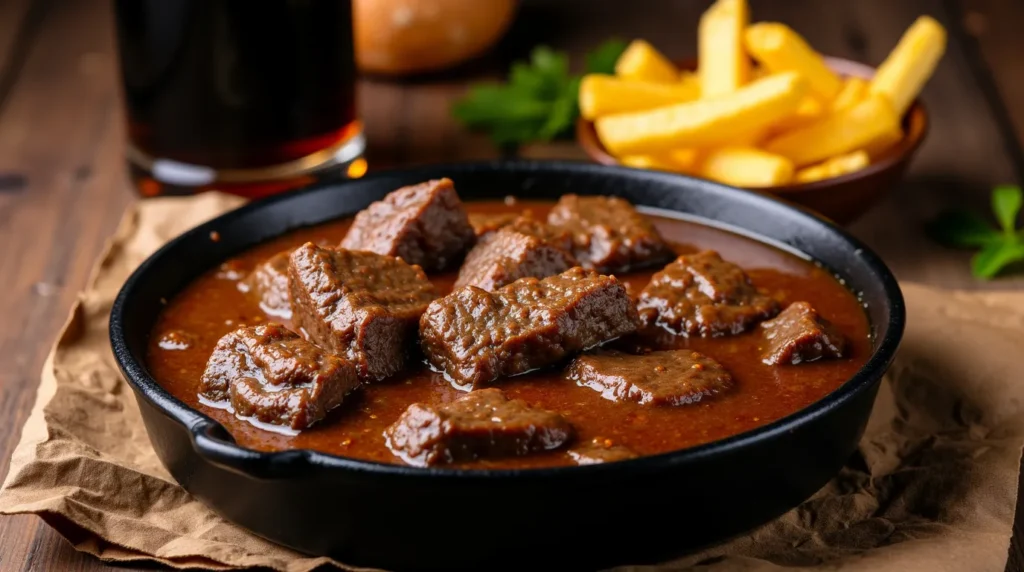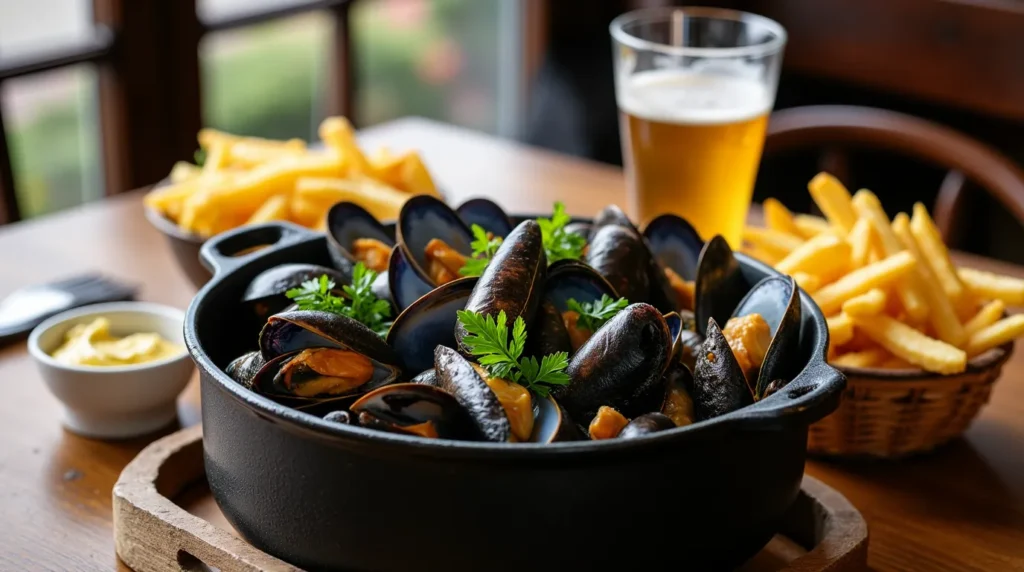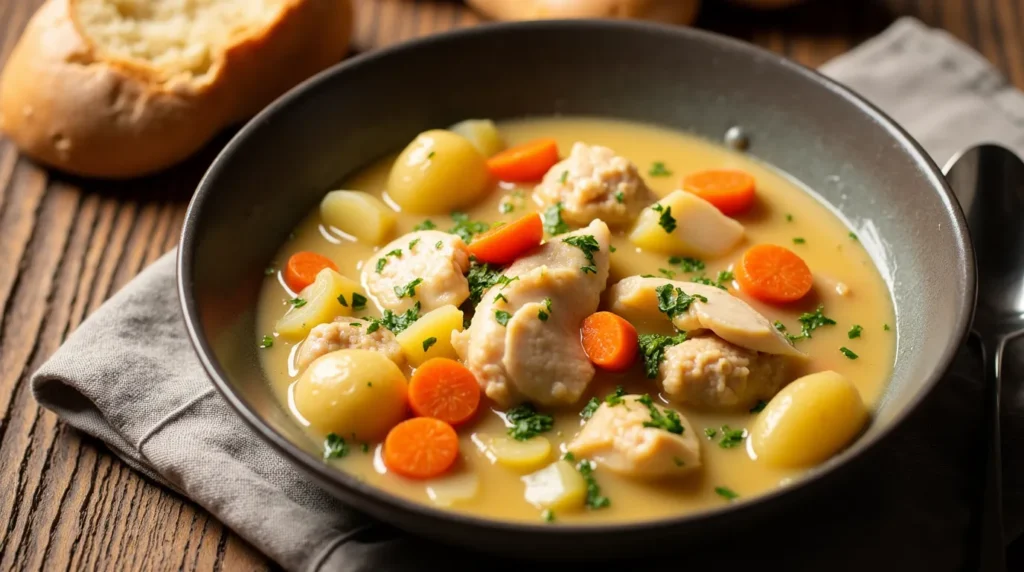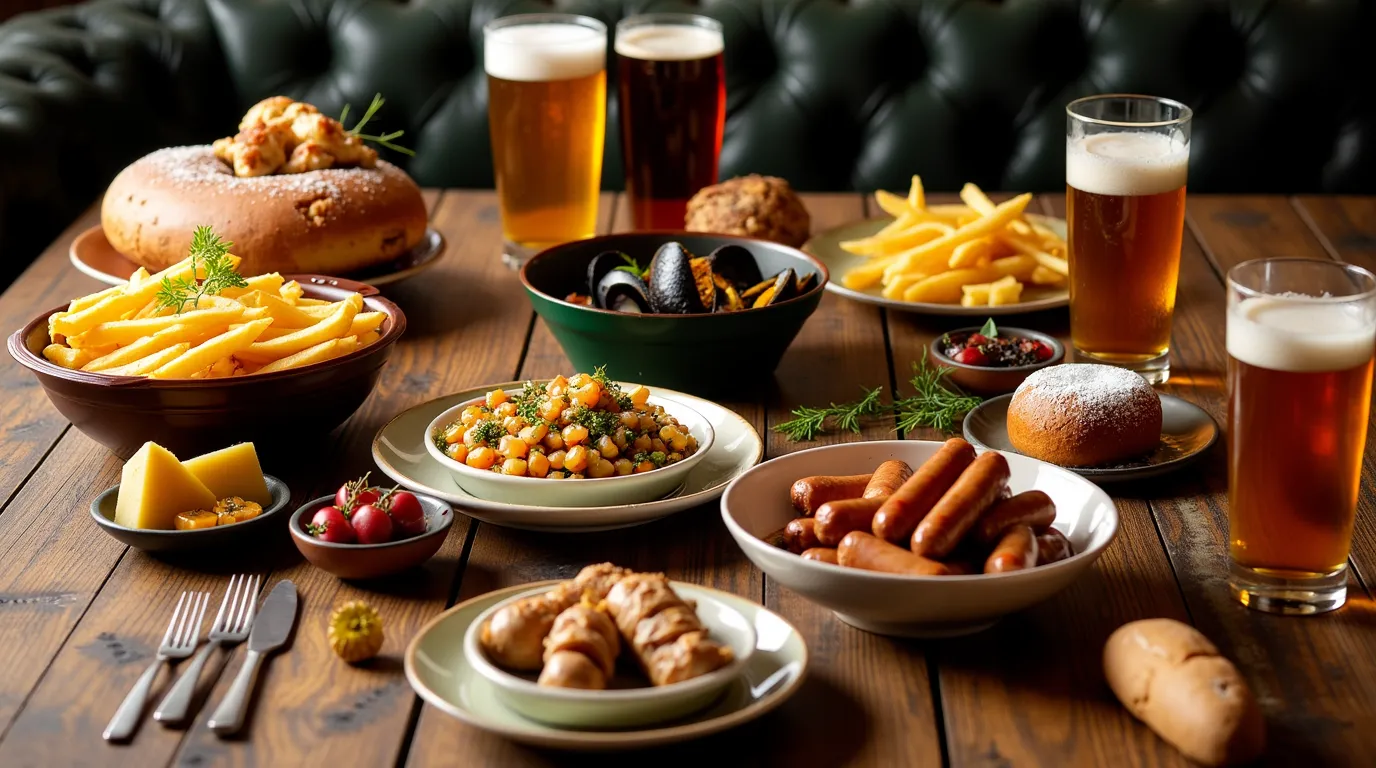Table of Contents
Table of Contents
Introduction
Belgium is a small yet remarkably diverse country nestled in the heart of Western Europe. Despite its modest size, it boasts a rich history, a vibrant cultural tapestry, and—perhaps most notably—a gastronomic heritage that is second to none. Belgian cuisine has long been celebrated by food enthusiasts for its hearty dishes, elegant presentations, and the careful balance of flavors that make every meal memorable. In many ways, Belgian cuisine acts as an appetizing bridge between the robust offerings of Germany, the refined finesse of France, and the comforting simplicity of Dutch cooking.
Yet, to define Belgian cuisine merely through its neighbors would be to ignore the distinct personality forged in Belgium’s own traditions, historical evolutions, and regional particularities. This nation is home to mouthwatering waffles, world-famous chocolates, iconic beers, and hearty stews—all of which have carved out a unique place on the global culinary stage. What truly sets Belgian cuisine apart, however, is its mastery of balance: Belgians revel in a style of cooking that marries familiarity with innovation, simplicity with sophistication, and local produce with exotic influences.
In this article, we will explore all facets of Belgian cuisine, from its historical roots and regional differences to its defining ingredients, must-try dishes, and modern evolution. Whether you are a curious traveler preparing for your first trip to Belgium, or a home cook eager to recreate authentic Belgian recipes in your own kitchen, this comprehensive guide will spark your imagination and whet your appetite. Let us begin this culinary journey, as we delve into the story behind one of Europe’s most captivating gastronomies.
Culinary Context and History
Ancient Roots and Medieval Feasts
The origins of Belgian cuisine date back centuries to the early settlements of Celtic and Germanic tribes in the region. Then under the Roman Empire, Belgica (the Latin name for the area roughly corresponding to modern-day Belgium) absorbed many of the agricultural and culinary practices introduced by Roman colonists. Over time, local tribes blended Roman techniques—such as baking bread in enclosed ovens and cultivating herbs like thyme, bay leaves, and rosemary—with their own foraging traditions, resulting in a hearty, rustic cuisine.
During the Middle Ages, the territory that is now Belgium became a patchwork of feudal states, some under the influence of the Holy Roman Empire, others under the Dukes of Burgundy. Noble banquets were extravagant affairs, often featuring roasted game, pies, and sauces thickened with bread—a technique still employed in certain classic Flemish preparations. This era popularized the liberal use of spices imported from distant lands, reflecting the importance of trade routes that traversed the region. Cloves, cinnamon, nutmeg, and pepper were considered symbols of wealth, and they found their way into medieval Belgian stews, sweet-and-sour sauces, and even pastries.
Trade, Colonization, and Global Influences
In later centuries, Belgium’s geographic location, combined with the maritime prowess of its neighbors, meant the Low Countries—including what is now Belgium—were at the crossroads of significant commercial and cultural exchanges. Cities like Antwerp and Bruges blossomed into major trade hubs, welcoming merchants from across Europe, the Middle East, and Asia. These connections introduced new produce—such as exotic fruits from the tropics—and new cooking methods, leading to a steady expansion of the Belgian culinary repertoire.
Belgium also established colonial presences overseas, most notably in the Congo. Although Belgium’s colonial history is complex and not without controversy, the exchange of cultural and culinary knowledge did bring certain African influences back to Belgian shores—particularly in the use of tropical fruits like plantains and ingredients such as peanuts. While these influences are more subtle compared to France’s or Britain’s colonial echoes, you can still find some Belgian dishes, especially in cosmopolitan cities like Brussels, featuring slight twists brought by African and Asian communities.
Regional Distinctions
One cannot fully understand Belgian cuisine without acknowledging the sharp regional distinctions within this small country. Belgium is divided into three main regions: Flanders to the north, Wallonia to the south, and the Brussels-Capital Region in the center. Flanders is predominantly Dutch-speaking, while Wallonia is French-speaking, and Brussels itself is officially bilingual. These linguistic and cultural differences have, over the centuries, given rise to notable culinary specializations:
- Flanders (North): The Flemish region is known for its robust, stew-centric cooking. Dishes like carbonnade flamande (a beef stew slow-cooked in beer) showcase the Flemish love for beer as both a beverage and a cooking ingredient. Flemish chefs also have a penchant for seafood, owing to the region’s proximity to the North Sea.
- Wallonia (South): The Walloon region boasts rustic dishes that reflect its agricultural and forested landscapes. Expect to find plenty of game (such as wild boar and venison) and freshwater fish, as well as rich sauces that exhibit French influences. This region is also home to preparations like boulets liégeois (meatballs in a sweet and tangy sauce) and tarte au riz (rice pie).
- Brussels-Capital Region (Center): Often considered a melting pot of gastronomic influences, Brussels embraces both Flemish and Walloon traditions, while also serving as Belgium’s multicultural capital. Here, one can savor everything from authentic moules-frites (mussels and fries) to international fusion menus, reflecting the city’s role as home to a large expatriate community and European Union institutions.
This unique blend of history, trade, and regional identities forms the backbone of Belgian cuisine. The result is a culinary tapestry that continues to evolve while remaining deeply rooted in a proud cultural heritage.
Key Ingredients and Local Products
Emblematic Foods of Belgian Cuisine
At the heart of Belgian cuisine are a few key ingredients that define its flavors and textures:
- Beer: Belgium is famous for its vast array of beers, from Trappist ales to lambic brews. Beer is not only served as a drink but also used liberally in cooking. It lends depth to stews like carbonnade flamande, and can also be used in batters for frying fish or making light, crispy waffles.
- Potatoes: Although potatoes are widespread in European cooking, Belgians have taken them to new heights, especially through frites (fries). Crisp on the outside and fluffy on the inside, Belgian fries are iconic and often served with mayonnaise or other flavorful sauces.
- Chocolate: With brands such as Neuhaus, Godiva, and Leonidas, Belgium’s contribution to the chocolate world is legendary. Pralines, truffles, and chocolate bars of every variety are standard fare, reflecting the country’s centuries-long tradition of chocolaterie craftsmanship.
- Waffles: There are two main types of Belgian waffles: Liege waffles, which are dough-based, sweet, and caramelized with pearl sugar, and Brussels waffles, typically lighter, rectangular, and made with a yeast-leavened batter.
- Fresh Produce and Meats: Belgian cooks prize local and seasonal ingredients. Vegetables like Belgian endive (chicon or witloof), leeks, Brussels sprouts, and asparagus are staples depending on the season. Meats such as pork, beef, and game (in winter months) are also widely featured.
- Mussels: Mussels, harvested from the North Sea, are hugely popular. Served in large steaming pots (marmites) often with fries, they come prepared in various broths—white wine, cream, or even beer-based.
- Speculoos: These spiced cookies, often made with cinnamon, nutmeg, and other warm spices, reflect the enduring medieval tradition of spiced pastries in Belgium. They are a beloved treat, enjoyed with coffee or as a sweet spread.
Seasonality in Belgian Cuisine
Like most European culinary traditions, Belgian cuisine places significant emphasis on seasonality. The climate in Belgium, with cool winters and mild summers, influences which dishes dominate at certain times of the year. In winter, heartier recipes like stews, gratins, and roasted game provide warmth and comfort. During spring and summer, lighter preparations with asparagus, endive, or fresh fish are more prevalent, and you will often see outdoor markets brimming with berries and other seasonal produce.
The importance of seasonality is also evident in holiday fare. For instance, around Christmas, Belgian households often prepare roasted meats, festive desserts, and special holiday cookies—enjoyed alongside mulled wine or dark seasonal beers. This cyclical approach to cooking ensures that dishes not only fit the climate but also taste their best when ingredients are at peak freshness.
Where to Find Key Ingredients
If you are keen on replicating Belgian cuisine at home, sourcing authentic ingredients is crucial:
- Local Markets: In Belgium, you will find weekly markets that offer fresh, locally grown produce, cheese, and artisanal bread—perfect for immersing yourself in the Belgian way of shopping and cooking. For those living outside Belgium, farmers’ markets or specialty European grocers often carry Belgian endives, leeks, and some local cheeses like Chimay or Herve.
- Specialty Stores: Look for stores that focus on European imports. Many will stock Belgian chocolate, speculoos cookies, and even Belgian beers, allowing you to incorporate these signature items into your recipes.
- Online Retailers: In today’s globalized market, you can find Belgian ingredients online, from artisanal chocolates to specific Belgian beer varieties. This option is especially convenient if you live in a region without well-stocked international shops.
Making the effort to procure the right ingredients pays off when you are aiming for authentic flavors. Freshness and quality are paramount—two values that lie at the very core of Belgian cuisine.
Must-Try Traditional Dishes
Carbonnade Flamande

Also known as stoofvlees in Dutch, carbonnade flamande is a rich beef stew cooked slowly in Belgian beer, typically a dark ale. The dish is mildly sweet and tangy, often thanks to the addition of brown sugar or a slice of bread slathered with mustard, which melts into the sauce. Traditionally served with fries or mashed potatoes, carbonnade flamande is a quintessential example of how beer is used to add layers of flavor in Belgian cuisine.
- History: The dish has medieval roots, reflecting how Belgian cooks have historically used beer as a primary stewing liquid when wine was too costly or scarce.
- Recipe Tip: To simplify, brown cubed beef in a pot, then sauté onions until golden. Add a dark Belgian beer, a slice of bread spread with mustard, and season with thyme, bay leaves, salt, and pepper. Let it simmer for at least two hours until the meat is tender and the sauce thick. Serve hot.
Moules-Frites

Often considered the national dish of Belgium, moules-frites is an iconic pairing of steamed mussels and fries. Mussels can be prepared in various ways: marinière (with white wine, onions, and celery), à la crème (with cream and herbs), or with a dash of Belgian beer. The fries, meanwhile, are double-fried to achieve their signature crispness.
- Characteristics: The beauty of moules-frites lies in its simplicity—fresh mussels steamed with aromatic seasonings and a side of perfectly fried potatoes.
- Regional Variations: In coastal Flemish towns, you might find mussels cooked in a rich tomato broth, whereas in Brussels, the default tends to be a marinière or beer-based sauce.
Waterzooi

Originally a fish stew from Ghent, waterzooi evolved to include chicken as well, especially as river fish became less abundant. This creamy, soup-like dish is composed of poultry or fish, vegetables (often carrots, leeks, and potatoes), and herbs, all simmered gently in a flavorful broth enriched with cream and egg yolk.
- History: Waterzooi’s name comes from the Dutch word “zooien,” meaning “to boil.” This dish dates back to medieval times when freshwater fish were plentiful in Flanders.
- Recipe Tip: Sauté chopped onions and leeks, add stock, carrots, and potatoes, then stir in the chicken or fish. Finish with a cream-egg mixture for richness.
Liège Waffles

While Brussels waffles are the more common international export, Liège waffles hold a special place in Belgian hearts due to their dense, sweet dough studded with pearl sugar. When cooked, the sugar melts and caramelizes, creating a heavenly, sticky exterior.
- History: Legend has it that the Liège waffle was created for the Prince-Bishop of Liège in the 18th century, inspired by brioche dough.
- Serving Suggestion: These waffles are often eaten plain or with a dusting of powdered sugar. You can also top them with fresh fruit, whipped cream, or a drizzle of Belgian chocolate sauce for extra indulgence.
Defining Characteristics of Belgian Cuisine
One of the most striking qualities of Belgian cuisine is its ability to offer both hearty comfort food and refined gastronomic experiences. It is not typically known for being very spicy; instead, it leans toward savory, rich, and occasionally sweet flavors. From the creaminess of waterzooi to the sweet tang of carbonnade’s beer sauce, Belgians showcase an expert balance of subtlety and depth.
- Flavor Combinations: Belgians love pairing sweetness with acidity or bitterness. Carbonnade flamande is a prime example, marrying the sweetness of caramelized onions and brown sugar with the slight bitterness of a dark ale. Similar sweet-sour dynamics appear in lapin à la gueuze (rabbit cooked in gueuze beer) or in sauces made with red currant jelly.
- Seasonings: Belgian chefs use classic European herbs such as thyme, bay leaf, parsley, and chives. Mustard and vinegar often contribute tanginess, while butter and cream add luxurious richness.
- Why It Appeals to Foodies: For those who crave something beyond the obvious gastronomic giants like French or Italian, Belgian cuisine offers an enticing middle ground—where the interplay of beer, high-quality dairy, fresh vegetables, and carefully chosen spices creates a comforting yet sophisticated profile. It’s perfect for adventurous eaters who appreciate tradition blended with subtle innovation.
Tips and Highlights to Encourage People to Try this Cuisine
- World-Famous Treats: Belgium’s waffles, fries, chocolates, and beers are internationally renowned for a reason. If you need a “gateway” dish to pique your interest, sampling these beloved specialties is a surefire way to fall in love with Belgian cuisine.
- Culinary Storytelling: Each dish has a backstory rooted in centuries of local traditions, from the medieval banquets of the Burgundian court to the fisherman’s catches along the Flemish coast. Delving into these narratives makes the culinary experience all the richer.
- Diverse Regional Offerings: The fact that Flanders, Wallonia, and Brussels each bring something unique to the table means there’s always something new to discover. Traveling between regions is like exploring three different gastronomic worlds.
- Perfect for Beer Lovers: For anyone who appreciates craft beer, Belgium is an absolute paradise. Incorporating these brews into your cooking process can be a fun experiment, adding new dimensions of flavor to your home-cooked meals.
- Approachable Techniques: Despite the elegance of many Belgian dishes, the core cooking methods—braising, frying, slow-cooking, baking—are quite accessible to home cooks. You don’t need specialized equipment, just patience and good-quality ingredients.
Table Rituals and Customs
Typical Meals
- Breakfast (Ontbijt/Petit Déjeuner): A light meal, usually consisting of bread, jam, cold cuts, and cheese. Coffee or hot chocolate often accompanies it. Pastries such as croissants or chocolate-filled buns may also appear.
- Lunch (Middageten/Déjeuner): Belgians often enjoy an open-faced sandwich or a simple dish like a quiche, salad, or soup, especially on workdays. However, more leisurely lunches can involve a hearty plate of stoemp (mashed potatoes with vegetables) or a small serving of stew with fries.
- Dinner (Avondeten/Dîner): The main meal of the day, dinner is typically enjoyed with family or friends. This is when elaborate dishes like carbonnade flamande, waterzooi, or roasted meats might appear, served alongside sides of potatoes, vegetables, and bread.
In Belgium, there is also the custom of having an aperitif—a pre-dinner drink (beer, wine, or sometimes a gin-based beverage) accompanied by small snacks like olives, cheese cubes, or bitterballen (fried meatballs). Dessert or a cheese course often follows dinner, especially during weekends or special occasions.
Table Etiquette
- Greetings: When you join a Belgian family or group of friends for a meal, a polite handshake or a quick kiss on the cheek (among closer acquaintances) is common.
- Cutlery Usage: Belgians typically use the continental style of dining—fork in the left hand and knife in the right hand throughout the meal.
- Hands on the Table: It’s considered polite to keep your hands visible (resting wrists on the edge of the table) rather than on your lap.
- Serving Customs: The host usually serves food, and guests often wait until everyone is served before starting to eat. It is polite to at least try all dishes offered.
Holidays and Celebrations
Belgium celebrates a variety of national and religious holidays, each with special culinary traditions:
- Christmas: Families gather around the table for roasted turkey or ham, seasonal vegetables, and special holiday desserts like kerststronk (a Yule log cake). Festive biscuits and spicy speculoos cookies add a warm, sweet touch.
- Saint Nicholas Day (December 6): Children receive gifts and sweets (often in the shape of the saint or other festive themes). Speculoos figurines and chocolate letters are highly common.
- Carnival and Lent: In certain parts of Belgium, you might encounter carnival festivities involving street foods, pastries, and sweet treats before the Lenten fasting period begins.
These traditions enrich Belgian cuisine with an element of festivity, reminding us of the strong ties between food, family, and celebration in Belgian culture.
Modern Trends and Culinary Fusions
Like many other global cuisines, Belgian cuisine continues to evolve. While preserving timeless classics, contemporary Belgian chefs are increasingly embracing foreign influences and sustainable practices.
- International Fusion: Brussels, in particular, is a melting pot of cultures. You can find restaurants blending Belgian staples with Moroccan, Congolese, Vietnamese, and other global flavors. Creative mash-ups might include a waterzooi with coconut milk or moules-frites served with lemongrass-infused broth.
- Vegetarian and Vegan Adaptations: As plant-based diets gain popularity, traditional Belgian dishes are being reimagined without meat or dairy. For example, carbonnade flamande can be made with seitan and a rich vegetable stock, while waterzooi might use tofu or jackfruit instead of chicken or fish.
- Farm-to-Table and Organic: Belgian chefs value local produce, and the farm-to-table movement has gained traction in recent years. Many high-end and even casual restaurants focus on sourcing ingredients from nearby farms to ensure freshness, reduce environmental impact, and support local agriculture.
- Young Culinary Talent: Belgium boasts a growing roster of young, innovative chefs who marry tradition with modern techniques. Some create tasting menus that rework classics like stoemp or chicon au gratin (endives with ham and cheese sauce) into elegant, bite-sized portions. Others experiment with molecular gastronomy, introducing foams, gels, and unexpected flavor pairings to surprise diners—all while keeping the soul of Belgian cuisine intact.
These evolving trends demonstrate that Belgian cuisine is far from static. It is a living, breathing tradition that honors its past while enthusiastically embracing the future.
Conclusion and Call to Action
In this journey through Belgian cuisine, we’ve explored a multitude of aspects that make this gastronomy so compelling. From its deeply rooted medieval past and its geographic position at the crossroads of European trade, to the distinctive regional differences between Flanders, Wallonia, and Brussels, Belgium’s culinary heritage is as diverse as it is rich. We’ve uncovered the quintessential ingredients—like beer, potatoes, Belgian endive, and chocolate—that lend signature tastes to Belgian dishes, and we’ve highlighted unmissable preparations such as moules-frites, carbonnade flamande, waterzooi, and Liège waffles.
Throughout this article, the defining characteristics of Belgian cuisine have shone through: hearty yet refined, balanced in taste, and deeply shaped by historical, cultural, and seasonal influences. We’ve seen how the cooking style is evolving in the modern era, with young chefs experimenting with fusion flavors and sustainable practices, ensuring that Belgian cuisine remains vibrant and relevant for future generations. Table rituals and customs further reveal the strong connections between food, community, and celebration in Belgian society.
Now, it’s your turn: Have you ever savored an authentic Belgian meal or tried your hand at cooking a Belgian dish at home? If so, share your experience—what did you prepare, and how did it turn out? If not, which dish are you most excited to explore first? We would love to hear your stories, tips, and questions about Belgian cuisine. Feel free to comment, reach out, or post your own cooking adventures.
In a future article, we might dive into the fascinating world of Belgian beer—its history, the various brewing techniques, and how to pair each style with the right dish. Until then, may your kitchen be filled with the comforting aromas and rich flavors that have long distinguished Belgian cuisine. Bon appétit—or as the Flemish say, Smakelijk eten!

